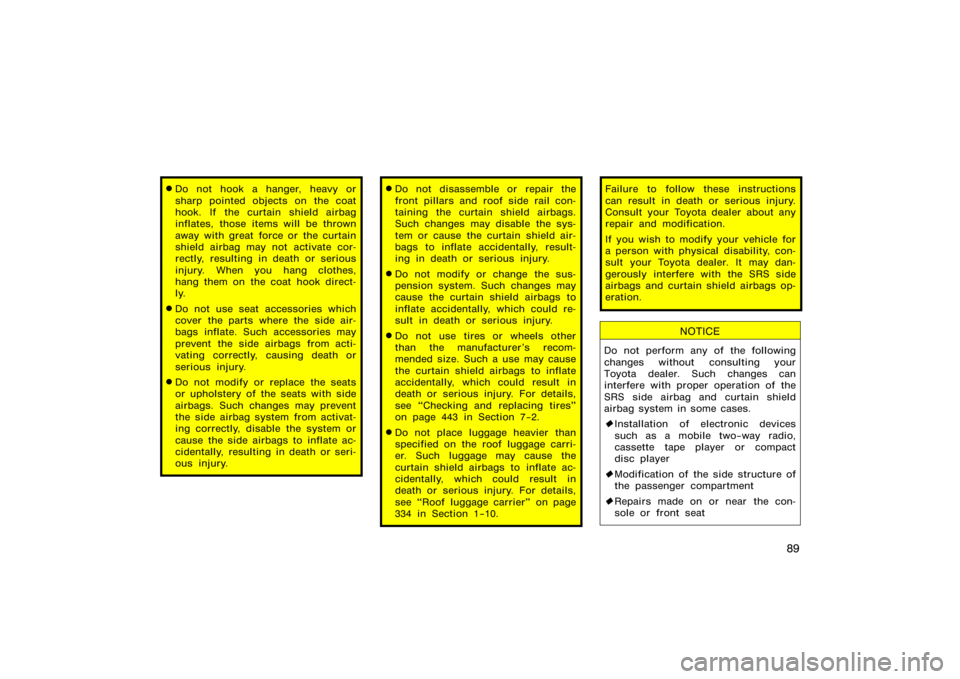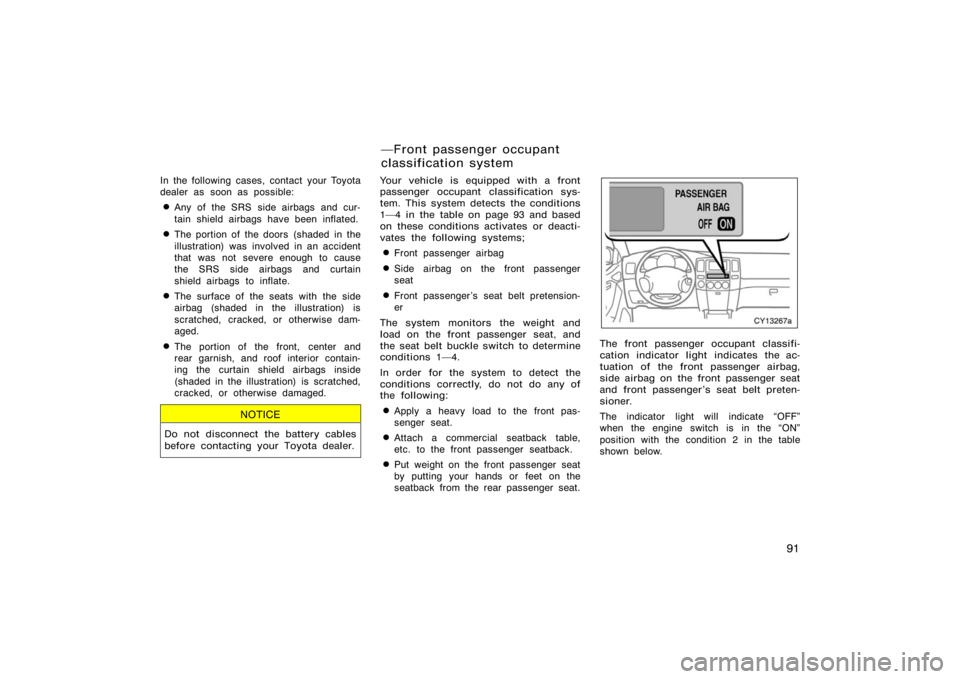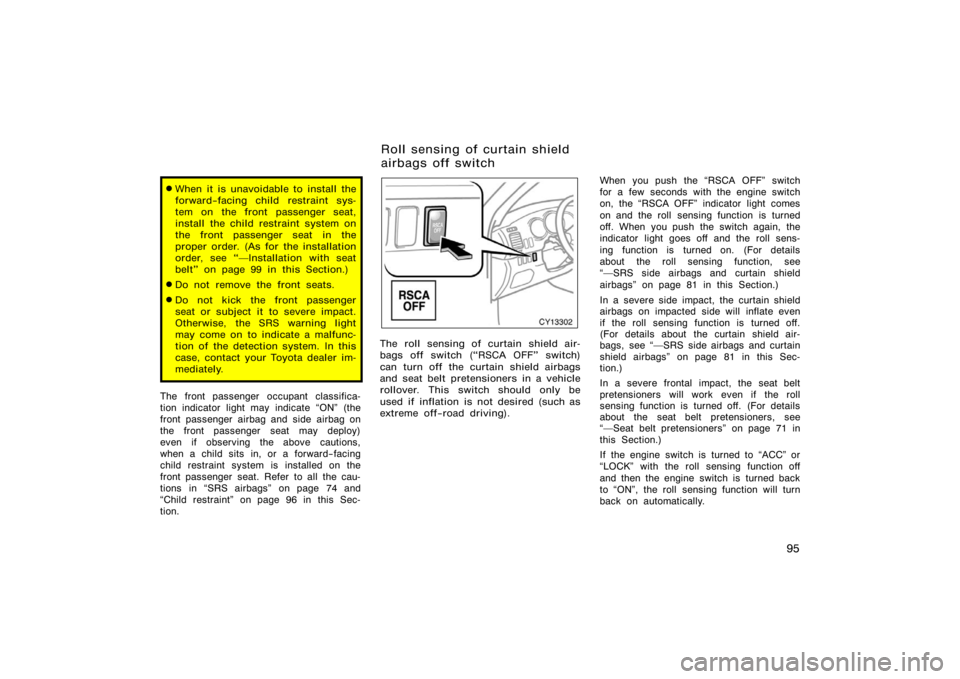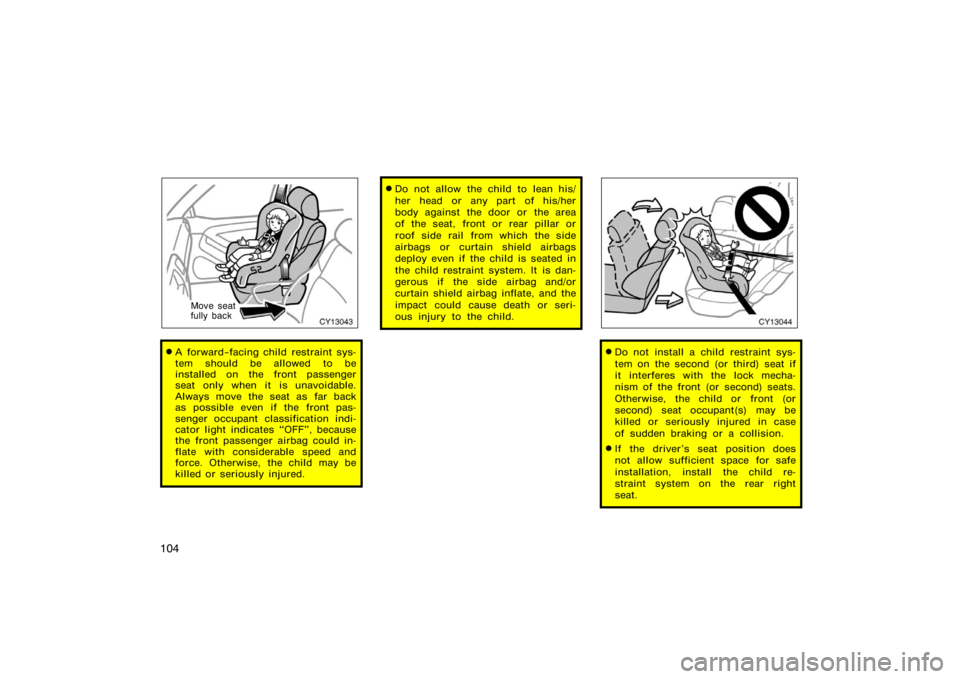Page 101 of 496

89
�Do not hook a hanger, heavy or
sharp pointed objects on the coat
hook. If the curtain shield airbag
inflates, those items will be thrown
away with great force or the curtain
shield airbag may not activate cor-
rectly, resulting in death or serious
injury. When you hang clothes,
hang them on the coat hook direct-
ly.
�Do not use seat accessories which
cover the parts where the side air-
bags inflate. Such accessories may
prevent the side airbags from acti-
vating correctly, causing death or
serious injury.
�Do not modify or replace the seats
or upholstery of the seats with side
airbags. Such changes may prevent
the side airbag system from activat-
ing correctly, disable the system or
cause the side airbags to inflate ac-
cidentally, resulting in death or seri-
ous injury.
�Do not disassemble or repair the
front pillars and roof side rail con-
taining the curtain shield airbags.
Such changes may disable the sys-
tem or cause the curtain shield air-
bags to inflate accidentally, result-
ing in death or serious injury.
�Do not modify or change the sus-
pension system. Such changes may
cause the curtain shield airbags to
inflate accidentally, which could re-
sult in death or serious injury.
�Do not use tires or wheels other
than the manufacturer’s recom-
mended size. Such a use may cause
the curtain shield airbags to inflate
accidentally, which could result in
death or serious injury. For details,
see �Checking and replacing tires"
on page 443 in Section 7−2.
�Do not place luggage heavier than
specified on the roof luggage carri-
er. Such luggage may cause the
curtain shield airbags to inflate ac-
cidentally, which could result in
death or serious injury. For details,
see �Roof luggage carrier" on page
334 in Section 1−10.
Failure to follow these instructions
can result in death or serious injury.
Consult your Toyota dealer about any
repair and modification.
If you wish to modify your vehicle for
a person with physical disability, con-
sult your Toyota dealer. It may dan-
gerously interfere with the SRS side
airbags and curtain shield airbags op-
eration.
NOTICE
Do not perform any of the following
changes without consulting your
Toyota dealer. Such changes can
interfere with proper operation of the
SRS side airbag and curtain shield
airbag system in some cases.
�Installation of electronic devices
such as a mobile two−way radio,
cassette tape player or compact
disc player
� Modification of the side structure of
the passenger compartment
� Repairs made on or near the con-
sole or front seat
Page 103 of 496

91
In the following cases, contact your Toyota
dealer as soon as possible:
�Any of the SRS side airbags and cur-
tain shield airbags have been inflated.
�The portion of the doors (shaded in the
illustration) was involved in an accident
that was not severe enough to cause
the SRS side airbags and curtain
shield airbags to inflate.
�The surface of the seats with the side
airbag (shaded in the illustration) is
scratched, cracked, or otherwise dam-
aged.
�The portion of the front, center and
rear garnish, and roof interior contain-
ing the curtain shield airbags inside
(shaded in the illustration) is scratched,
cracked, or otherwise damaged.
NOTICE
Do not disconnect the battery cables
before contacting your Toyota dealer.
Your vehicle is equipped with a front
passenger occupant classification sys-
tem. This system detects the conditions
1�4 in the table on page 93 and based
on these conditions activates or deacti-
vates the following systems;
�Front passenger airbag
�Side airbag on the front passenger
seat
�Front passenger ’s seat belt pretension-
er
The system monitors the weight and
load on the front passenger seat, and
the seat belt buckle switch to determine
conditions 1�4.
In order for the system to detect the
conditions correctly, do not do any of
the following:
�Apply a heavy load to the front pas-
senger seat.
�Attach a commercial seatback table,
etc. to the front passenger seatback.
�Put weight on the front passenger seat
by putting your hands or feet on the
seatback from the rear passenger seat.
CY13267a
The front passenger occupant classifi-
cation indicator light indicates the ac-
tuation of the front passenger airbag,
side airbag on the front passenger seat
and front passenger’s seat belt preten-
sioner.
The indicator light will indicate �OFF"
when the engine switch is in the �ON"
position with the condition 2 in the table
shown below.
�Front passenger occupant
classification system
Page 107 of 496

95
�When it is unavoidable to install the
forward−facing child restraint sys-
tem on the front passenger seat,
install the child restraint system on
the front passenger seat in the
proper order. (As for the installation
order, see ��Installation with seat
belt" on page 99 in this Section.)
�Do not remove the front seats.
�Do not kick the front passenger
seat or subject it to severe impact.
Otherwise, the SRS warning light
may come on to indicate a malfunc-
tion of the detection system. In this
case, contact your Toyota dealer im-
mediately.
The front passenger occupant classifica-
tion indicator light may indicate �ON" (the
front passenger airbag and side airbag on
the front passenger seat may deploy)
even if observing the above cautions,
when a child sits in, or a forward−facing
child restraint system is installed on the
front passenger seat. Refer to all the cau-
tions in �SRS airbags" on page 74 and
�Child restraint" on page 96 in this Sec-
tion.
CY13302
The roll sensing of curtain shield air-
bags off switch (�RSCA OFF" switch)
can turn off the curtain shield airbags
and seat belt pretensioners in a vehicle
rollover. This switch should only be
used if inflation is not desired (such as
extreme off−road driving).When you push the �RSCA OFF" switch
for a few seconds with the engine switch
on, the �RSCA OFF" indicator light comes
on and the roll sensing function is turned
off. When you push the switch again, the
indicator light goes off and the roll sens-
ing function is turned on. (For details
about the roll sensing function, see
��SRS side airbags and curtain shield
airbags" on page 81 in this Section.)
In a severe side impact, the curtain shield
airbags on impacted side will inflate even
if the roll sensing function is turned off.
(For details about the curtain shield air-
bags, see ��SRS side airbags and curtain
shield airbags" on page 81 in this Sec-
tion.)
In a severe frontal impact, the seat belt
pretensioners will work even if the roll
sensing function is turned off. (For details
about the seat belt pretensioners, see
��Seat belt pretensioners" on page 71 in
this Section.)
If the engine switch is turned to �ACC" or
�LOCK" with the roll sensing function off
and then the engine switch is turned back
to �ON", the roll sensing function will turn
back on automatically.
Roll sensing of curtain shield
airbags off switch
Page 111 of 496
99
CY13141
(A) INFANT SEAT INSTALLATION
An infant seat must be used in rear−
facing position only.
CY13034
CAUTION
�Never install a rear−facing child re-
straint system on the front passen-
ger seat even if the front passenger
occupant classification indicator
light indicates �OFF". In the event
of an accident, the impact of the
rapid inflation of the front passen-
ger airbag could cause death or se-
rious injury to the child if the rear−
facing child restraint system is
installed on the front passenger
seat.
CY13035
�Do not install a child restraint sys-
tem on the second (or third) seat if
it interferes with the lock mecha-
nism of the front (or second) seats.
Otherwise, the child or front (or
second) seat occupant(s) may be
killed or seriously injured in case
of sudden braking or a collision.
�If the driver’s seat position does
not allow sufficient space for safe
installation, install the child re-
straint system on the rear right
seat.
�Installation with seat belt
Page 116 of 496

104
CY13043
Move seat
fully back
�A forward−facing child restraint sys-
tem should be allowed to be
installed on the front passenger
seat only when it is unavoidable.
Always move the seat as far back
as possible even if the front pas-
senger occupant classification indi-
cator light indicates �OFF", because
the front passenger airbag could in-
flate with considerable speed and
force. Otherwise, the child may be
killed or seriously injured.
�Do not allow the child to lean his/
her head or any part of his/her
body against the door or the area
of the seat, front or rear pillar or
roof side rail from which the side
airbags or curtain shield airbags
deploy even if the child is seated in
the child restraint system. It is dan-
gerous if the side airbag and/or
curtain shield airbag inflate, and the
impact could cause death or seri-
ous injury to the child.
CY13044
�Do not install a child restraint sys-
tem on the second (or third) seat if
it interferes with the lock mecha-
nism of the front (or second) seats.
Otherwise, the child or front (or
second) seat occupant(s) may be
killed or seriously injured in case
of sudden braking or a collision.
�If the driver’s seat position does
not allow sufficient space for safe
installation, install the child re-
straint system on the rear right
seat.
Page 121 of 496
109
CY13118
To remove the booster seat:
Press the buckle release button and allow
the belt to retract.
CY13306
Follow the procedure below for a child
restraint system that requires the use
of a top strap.
CY13307
Symbol
Anchor brackets
Use the anchor brackets behind the rear
seatbacks to attach the top strap.
Anchor brackets are installed for each
rear seating position.
This symbol indicates the locations of the
anchor brackets.
� U sin g a to p st rap
(vehicles without third seats)
Page 124 of 496
11 2
CY13308
Follow the procedure below for a child
restraint system that requires the use
of a top strap.
CY13242
Anchor bracketsSymbol
Use the anchor brackets behind the sec-
ond seatbacks to attach the top strap.
Anchor brackets are installed for each
second seat.
This symbol indicates the locations of the
anchor brackets.
CY13219
TO USE THE ANCHOR BRACKET:1. Remove the head restraint.
� U sin g a to p st rap
(vehicles with third seats)
Page 126 of 496
11 4
CY13222
4. Replace the head restraint.
Close the anchor bracket cover when the
anchor bracket is not used.
CY13175
Lower anchorages for the child restraint
systems complying with the FMVSS225
or CMVSS210.2 specifications are
installed in the rear seats.
The anchorages are installed in the gap
between the seat cushion and seatback of
both outside rear seats.
Child restraint systems complying with the
FMVSS213 or CMVSS213 specification
can be fixed to these anchorages. In this
case, it is not necessary to fix the child
restraint system with a seat belt on the
vehicle.CY13262
Canada only
Ty p e A
�Installation with child
restraint lower anchorages
(vehicles without third seats)